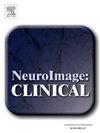儿童轻度创伤性脑损伤后皮层髓鞘形成变化的一年纵向研究
IF 3.6
2区 医学
Q2 NEUROIMAGING
引用次数: 0
摘要
小儿轻度创伤性脑损伤(pmTBI)对皮质(即灰质)髓鞘形成的影响尚不清楚,特别是与神经发育的相互作用。目前的研究通过使用T1w/T2w比值法估计髓鞘含量,研究了pmTBI相对于健康对照组(HC)对皮质髓鞘形成的影响。数据来自pmTBI (N = 217)参与者,分别在损伤后约7天(第1次访问[V1])、4个月(第2次访问[V2])和1年(第3次访问[V3]),具有年龄和性别匹配的HC (N = 180)的等效采样点。临床结果显示,脑震荡后V1到V3的症状只有部分恢复,睡眠、功能结局、行为和长期记忆也有类似的不完全恢复。髓磷脂含量随着实足年龄的增长而增加,并在研究访问中以半球特定的方式作为个体衰老的功能(左>;右),最明显的是在后顶叶。女性的髓磷脂含量也高于男性。有证据表明,损伤后4个月,pmTBI组的后顶叶皮层髓鞘形成减少,损伤后1年,左前额叶皮层髓鞘形成增加。然而,这些发现都没有通过各种敏感性分析,这表明pmTBI对皮质髓磷脂含量的影响很小。总之,尽管髓磷脂含量的快速变化是神经发育的一种功能,但几乎没有证据表明pmTBI永久性地改变了皮质髓磷脂的发育轨迹。本文章由计算机程序翻译,如有差异,请以英文原文为准。
A one year longitudinal study of cortical myelination changes following pediatric mild traumatic brain injury
The impact of pediatric mild traumatic brain injury (pmTBI) on cortical (i.e., grey matter) myelination is not yet understood, especially for interactions with neurodevelopment. The current study examined the impact of pmTBI on cortical myelination relative to healthy controls (HC) by estimating myelin content using the T1w/T2w ratio method. Data were obtained from pmTBI (N = 217) participants at approximately 7 days (Visit 1 [V1]), 4 months (Visit 2 [V2]), and 1 year (Visit 3 [V3]) post-injury, with equivalent sampling points for age and sex-matched HC (N = 180). Clinical results suggested only partial recovery from post-concussive symptoms from V1 to V3, with similar incomplete recovery of sleep, functional outcomes, behavior, and long-term memory. Myelin content increased with chronological age and as a function of individual aging across study visits in a hemisphere specific fashion (left > right), most visibly within the posterior parietal lobe. Myelin content was also greater for females relative to males. There was evidence of both a reduction in myelination within the posterior parietal cortex for the pmTBI group at 4 months post-injury, as well as evidence of increased myelination within the left prefrontal cortex at one-year post-injury. However, neither of these findings survived various sensitivity analyses, suggesting that there were minimal effects of pmTBI on cortical myelin content in general. In summary, although rapid changes in myelin content existed as a function of neurodevelopment, there was little evidence to suggest that pmTBI permanently altered cortical myelin development trajectories.
求助全文
通过发布文献求助,成功后即可免费获取论文全文。
去求助
来源期刊

Neuroimage-Clinical
NEUROIMAGING-
CiteScore
7.50
自引率
4.80%
发文量
368
审稿时长
52 days
期刊介绍:
NeuroImage: Clinical, a journal of diseases, disorders and syndromes involving the Nervous System, provides a vehicle for communicating important advances in the study of abnormal structure-function relationships of the human nervous system based on imaging.
The focus of NeuroImage: Clinical is on defining changes to the brain associated with primary neurologic and psychiatric diseases and disorders of the nervous system as well as behavioral syndromes and developmental conditions. The main criterion for judging papers is the extent of scientific advancement in the understanding of the pathophysiologic mechanisms of diseases and disorders, in identification of functional models that link clinical signs and symptoms with brain function and in the creation of image based tools applicable to a broad range of clinical needs including diagnosis, monitoring and tracking of illness, predicting therapeutic response and development of new treatments. Papers dealing with structure and function in animal models will also be considered if they reveal mechanisms that can be readily translated to human conditions.
 求助内容:
求助内容: 应助结果提醒方式:
应助结果提醒方式:


